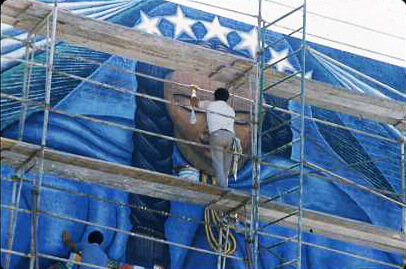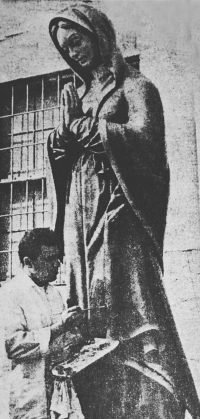In the early 60’s, Jose Luis had started to market woodcarvings under the name of GOEZ, at the Great Western in the city of Commerce, California.
One of Jose Luis’ first projects in the community was the design and installation of a large mural, in East Los Angeles, depicting the apparition of La Virgen de Guadalupe to the Indian San Juan Diego completed in 1969, executed in mosaics, and graced with life sized, hand carved marble statues. This project was funded by Utter McKinley Mortuary and installed at Our Lady of Guadalupe Sanctuary Catholic Church.
Before the end of the decade, Jose Luis decided to start an art studio and gallery in the community. He contacted his brother, Juan, who was residing in Spain at the time, to return to Los Angeles to join him in the venture of further developing Goez Art Studio and Gallery in East Los Angeles; which turned out to be the first art studio and gallery in the country to dedicate its resources to Chicano art and artists. Later, Juan invited his high school friend, David Botello, to participate; and Jose Luis invited Robert Arenivar whose artistic contributions enhanced the creation of many murals and designs until his demise in 1985.
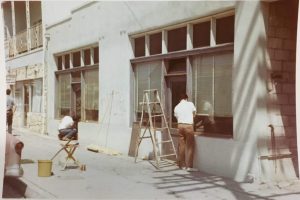
So much work went into clearing out all old, dirty meat packing equipment and refinishing the facade to ready the building for Goez Art Studio & Gallery.
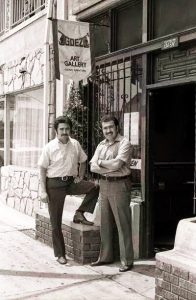
Joe Gonzalez and his brother Juan at the entrance of the first Goez Art Studio & Gallery, that located at 3757 East First Street, East Los Angeles
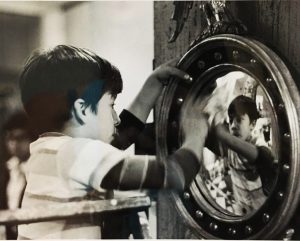
Here is Joe’s youngest son, Arthur Gonzalez, readying Goez Art Studio & Gallery in East Los Angeles for the opening on 1971.
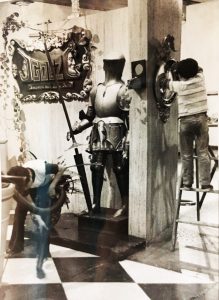
Another view of a young helper, Arthur Gonzalez, with his older brother, Manuel Gonzalez, as they work in preparation for the opening of Goez Art Studio & Gallery in 1971.

Goez Art Studio & Gallery (1971)
David resigned for other endeavors in 1974; and in the late 1970’s, Juan left Goez, too. Jose Luis operated Goez Art Studio until 2018. Throughout the course of the many years and five galleries, he has accumulated a large collection of artworks by Chicano artists; some of which you can see in the Collections tab.
Following are some examples of works and projects:
Jose Luis was commissioned to restore the 1,000-year-old marble sarcophagus that contained ashes of Mahatma Gandhi for the Self Realization Fellowship.
Jose Luis’ projects reflect his pioneering spirit. Goez Art Studio and Gallery, which included the Goez Institute of Murals and Fine Arts, has for decades been responsible for countless murals gracing major developments in the Los Angeles and surrounding areas.
One of the first Chicano murals created at GOEZ, for its façade, was the mural titled; “The Birth of Our Art” which was designed by brother Juan and assisted by several artists, also encouraged and taught other artists to participate in the event of painting murals as the movement that would spread throughout our nation.
The first largest art exhibit held at GOEZ involved over 95 Mexican-American or Chicano artists. The development of GOEZ was a vehicle which led to the events that took place in the community related to the fine arts, such as, a personal invitation from Warner Buck, President-Producer of the First Home Show at the then New Los Angeles Convention Center, to exhibit and demonstrate the production of fine arts works, by introducing five different artists every other day for the duration of the Home Show.
This was followed by a similar invitation from Universal Studios for the famous October Fest. Both events were a first for Chicano artists.
Jose Luis has been on at least 200 television and radio shows, as well as newspaper and magazine articles, arranged many exhibitions, bringing exposure to help promote Chicano artists and their works. GOEZ was chosen as one of five in the nation to be filmed and shown nationally as an example of its accomplishments by a minority organization geared towards the betterment of its community through human development.
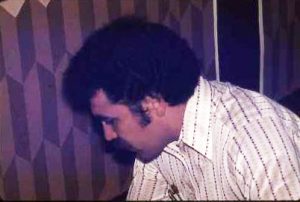
Joe painting the baptistery at San Fernando Mission.
Following the devastating Sylmar Earthquake of 1971, the Archdiocese of Los Angeles selected Jose Luis to head the restoration efforts of the valuable collection of hand carved wooden statues of the San Fernando Mission and the re-creation of the art on the walls and beams in the interior of the mission that had been painted by the Indians in 1797.
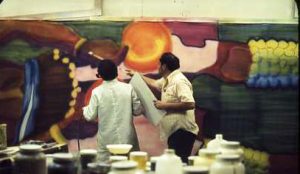
The production of the banners was accomplished as teamwork! I would stretch out the canvas to the frame, spray three coats of gesso, Robert would start drawing and immediately I would follow with the spraying of the colors. I used only primary colors.

The banners for the Los Angeles Music Center were 28 ft tall by 6 ft wide and had to be produced sideways. We would complete one each day.
The Music Center commissioned Jose Luis to design and execute 23 large banners, 28ft. high by 6ft. wide, for the 1974, 5 de Mayo Celebration. The banners were painted utilizing a technique, developed by Jose Luis, of airbrushing using only four colors which made it possible to paint one each day. Due to the length of the panels, they were painted sideways.
Jose Luis, as Chairman for the Fine Arts Committee for the Music Center’s 5 de Mayo Celebration for four consecutive years, organized the largest conglomeration of Chicano artists ever assembled in one place for an art contest and show at the Music Center, and the Paseo de Los Pobladores, in Los Angeles.
Jose Luis had a very good relationship with Robert Kemp, owner of the First Street Store, a very popular store in the community of East Los Angeles, because his wife, Blanca Rosa Gonzalez was employed there. Robert Kemp commissioned Jose Luis to design 18 murals that were executed in ceramic tile, totaling 1,123 square feet, and titled “A History of Our Struggle”.
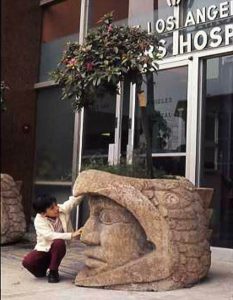
My son, Arthur Gonzalez, then a child, closely inspecting the Head of Eagle Knight of the Aztecs in front of the East Los Angeles Doctors Hospital.
Jose Luis created an opportunity to practice his motto of “edification through beautification” in the community by developing a program to design and produce large heads representing important figures of pre-Columbian era. With the assistance of various artists, several heads, such as the Eagle Knight of the Aztecs, the Toltec, and the Olmec, were produced and served as planters at the East Los Angeles Doctors Hospital and throughout the community. This prompted exposure and sale of many other works of art by different artists that were produced at GOEZ.
Jose Luis and his brother, Juan, were featured on the Dewar’s Profile which appeared in 24 national magazines and 62 newspapers in 1975.
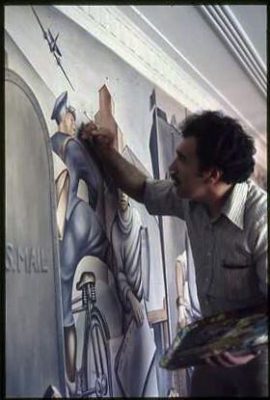
Joe Gonzalez restoring the San Pedro Office mural.

News article during the restoration of the San Pedro mural. News Pilot, Vol 45, #142, San Pedro CA, Aug 20 1975
P.J. Walker commissioned Jose Luis, in August of 1975, to restore a mural, titled “Mail Transportation” that was painted by Fletcher Martin during the W.P.A. period (1938), at the San Pedro Post Office. Joe was assisted by Josephine Quesada. The approximate dimensions of this mural: 6’ x 50’. This project was very challenging because it had to be completed in 50 hours to allow other trades to come in and finish their part of the restoration of San Pedro’s main post office lobby.
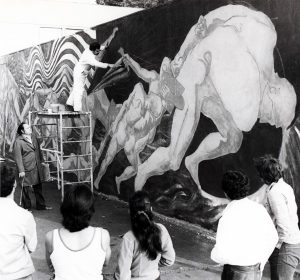
Ad Astra per Aspera ~ Through Difficulty to the Stars mural at USC. Jose Luis Gonzalez on the ladder and Robert Arenivar assisted in the design and production of this mural.
Jose Luis Gonzalez was elected Chairman of the U.S. Hispanic Bicentennial Cultural Committee for the City of Los Angeles in 1975-1976. During this time, he designed and introduced a mural program that would involve 1,500 artists, and 7,500 students in the production of murals throughout the City of Los Angeles and its surrounding communities. Initiating the program was the mural painted for MECHA at the University of Southern California titled, “Ad Astra Per Aspera”- “Through Difficulty to the Stars”. The proposal was officially recorded in the Los Angeles records as a United States Bi-Centennial project.
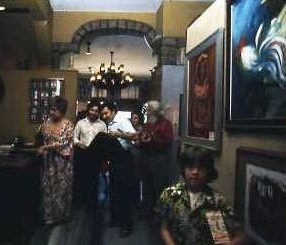
Deputy Mayor, Grace Montanez Davis, presents commendations from Los Angeles Mayor, Tom Bradley, to each muralist who had painted 5 murals or more. This was an idea that Joe Gonzalez thought would help promote and honor those artists that worked and taught their apprentices to paint murals. The City declared April 25, 1976, East Los Angeles Mural Day.
GOEZ artists were very instrumental in the development of the mural movement throughout Southern California. On one important occasion, 15 artists received a resolution that was passed by the Honorable Art Torres of the Fifty-Sixth Assembly District and the Honorable Richard Alatorre of the Fifty-Fifth Assembly District declaring that April 25, 1976 would be recognized as “East Los Angeles Mural Day” for the artists that had painted five murals or more.
One of the most important contributions that GOEZ provided to the community was the creation of the first studio gallery with museum-type atmosphere where year-round tours of students from pre-school to university level were an ongoing activity. They observed many artists creating a variety of works of art utilizing different mediums. GOEZ was responsible for giving Chicano artists international exposure through filming of community murals by German and French film companies. Part of this exposure was the invitation by the World Peace Congress to participate in the First Chicano Art Exhibit in Russia where works by two of Goez’s artists were purchased for the Pushkin Museum.
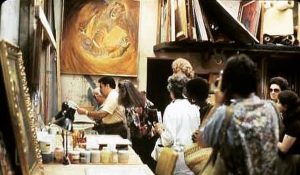
Many tour groups visited Goez where they saw at least 20 artists working throughout the workshops using different mediums.
The ongoing activities at the GOEZ ART STUDIO and GALLERY plus the production of many murals in the community contributed to the development of East Los Angeles into a tourist attraction receiving commendations to this effect from the City, County and State.

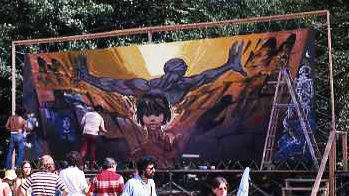
This mural brought tremendous exposure to the movement of creating murals to help promote the artists and their work. The project included Eddie Martinez, designer of the mural and artist assistants: Jacob W. Gutierrez, Robert Arenivar, Juan and Joe L. Gonzalez. 1975 American Folklife Festival in Washington, D.C.
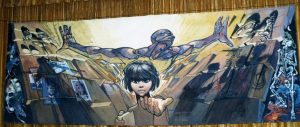
Joe stated, “I was asked to present the mural, “Future of Innocence”, for an open house event at my Alma Mater, Don Bosco Technical Institute.”
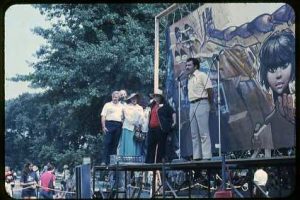
Joe Gonzalez on stage for the dedication of the commissioned mural by the Smithsonian Institute for the 1975 American Folklife Festival in Washington DC. The mural was transported from Goez Gallery unfinished so that it would be completed in public display.
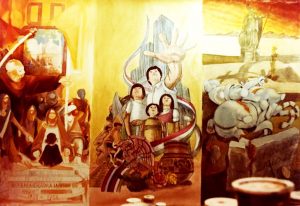
Unfinished mural for the Smithsonian Institute for display at the 1976 American Folklife Festival in Washington, D.C.
The Smithsonian Institute commissioned GOEZ for two consecutive years, 1975-1976, to paint two large murals, 10ft. by 30ft., for the American Folk Life Festival, in Washington D.C.

This shows the progress of the mural titled, “Employment Through the Ages” in the California Department of Employment building in Los Angeles.

This section of the mural was painted in the stairwell. We wanted to depict different forms of employment from the cavemen hunters, basket weavers, poets, musical composers, printers, to spacemen, and others that we could relate to.
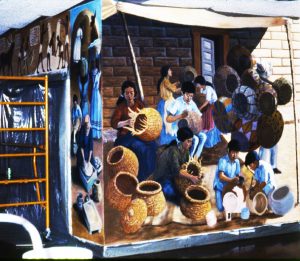

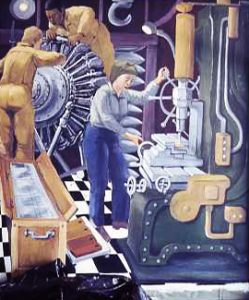
Jose Luis won a state-wide contest; was awarded the contract to paint a 900 sq ft mural depicting “Employment through the Ages”. It was painted in the lobby of the Employment Development Department Building under CETA. During the production of the mural, six college art students from different colleges were invited as apprentices and were taught the techniques of painting a mural directly on the wall.
Jose Luis has been featured in Who’s Who in American Art since 1976.
In 1976, Raymond Girvigian, FAIA Architect, contracted Jose Luis to restore 1,500 different antique ceramic tiles and fixtures for “La Casa Nueva” at Workman Temple Home, an adobe house built in early 1840’s and a historic landmark in the City of Industry. California’s last Mexican Governor, Pio Pico, is interred at this location.
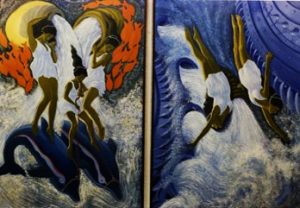
Earth Sign: Air
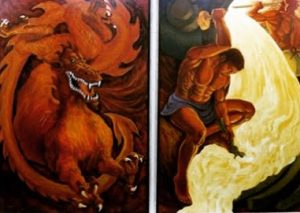
Earth Sign: Fire
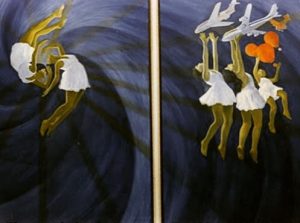
Earth Sign: Water
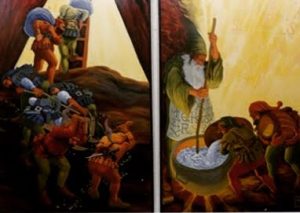
Earth Sign: Earth
Jose Luis was commissioned to paint some murals for the inside of the Benjamin Franklin Library on 1st Street in Boyle Heights, in 1978, and decided to paint the four elements as described by Plato: air, fire, water, and earth. There are eight panels, each measuring 9ft. high by 7ft. wide.
Jose Luis was commissioned to design, produce, and install a ceramic tile mural for the exterior of the City Terrace Library in 1979, titled “Ofrenda Maya” ~ “Mayan Offering”.
In 1981 for the 200th birthday of the City of Los Angeles, the Los Angeles 200 Committee and Mayor Bradley appointed Jose Luis as a representative of one of the 44 Founding Fathers for the City of Los Angeles. Later, on behalf of Los Angeles Sister City Committee with Mexico City, Mayor Tom Bradley commissioned Jose Luis to design and present a special ceramic tile plaque to Mexico City’s Mayor, Professor Hank Gonzalez, at a gala City Hall ceremony; and, unexpectedly, Mayor Gonzalez presented Jose Luis with a bronze medallion of Mexico City.
In the same year, Jose Luis opened a Gallery at Olvera Street, a historical site, to exhibit and sell works by Chicano artists, in his ongoing determination to promote their works. This was followed by an invitation to open another Gallery in Disneyland’s Seaports of the Pacific, also to help expose the works of the talented Chicano artists.

As we were outgrowing the gallery in East Los Angeles, I started looking to expanding the exposure of the works for our artists. As Olvera Street is a great tourist center, it made sense to open a gallery there.
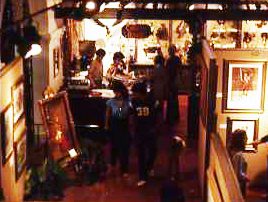
This section is the entrance to Goez Gallery at Olvera Street and many guests were received, daily.
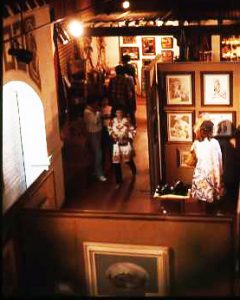
The Gallery at Olvera Street was 3,700 sq. ft. which was adequate space for display and presentation of art works by Chicano artists.
Jose Luis arranged an exhibit named “Imagenes de la Raza”, consisting of works by at least 40 artists for the Amerika Haus Berlin in conjunction with Horizonte’ 82-2nd Festival of World Cultures, Berlin, June-July 1982.
In 1983, Jose Luis was asked by the president of The East Los Angeles Community Union (TELACU) to design a ceramic tile mural for the new office building that had just been constructed in the city of Commerce, near Olympic and Atlantic Boulevards. The mural was designed, executed, and installed measuring 3 stories high by 23 ft., and is titled, “Orgullo de Nuestra Herencia” ~ “Pride of Our Heritage”. This mural is comprised of 3,500 hand glazed and fired ceramic tiles.
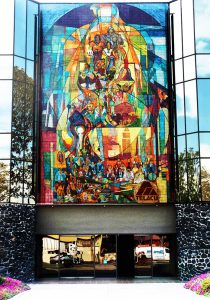
TELACU Building located at Olympic & Goodrich Blvds, Commerce, CA.
Jose Luis was Art Director for Domingos Alegres an entertainment program that was held weekly at the Belvedere Park in East Los Angeles, and sponsored by TELACU, involving the participation of many famous performers, as free entertainment for the people of the E.L.A. Community. Jose Luis would design, produce, and install the sets for the stage for the performance for each show and strike the set after each event.
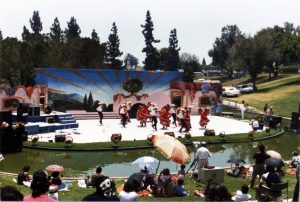
One example of stage design for weekly entertainment shows at Belvedere Park in the 1980’s.
In 1983, Jose Luis executed, transported, and installed a large painting in classical Baroque style, 10ft. high by 22ft. wide, for the Clift Hotel in San Francisco.

Here is a picture of my sons Joe, Jr. and Manuel to the left of me. I am at the far right.
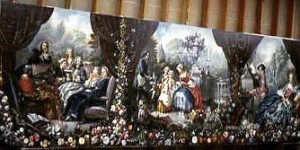
This painting for the Clift Hotel was designed by Eddie Martinez, Joe L. Gonzalez, Project Director and Artist, and Goez Artists, Gustavo Kasias and Tony Ramirez, installed by Eddie, my sons, Joe, Jr., Manuel and me.
Jose Luis Gonzalez designed and executed the Official Olympic Mural for the XXIII Olympiad titled “Bienvenidos a la Ciudad de Nuestra Señora La Reina de Los Angeles de Porciuncula”, held in the City of Los Angeles, 1984. The mural is 45ft.high by 132ft. wide, located at 3965 S. Vermont Ave. (mural faces Leighton St.), Los Angeles, CA 90037

“Bienvenidos a la Ciudad de Nuestra Señora La Reina de Los Angeles de Porciuncula” designed by Joe L. Gonzalez.
During the production of the official 1984 Olympic mural, Mr. Pedro Rosado, owner of the East Los Angeles landmark, El Mercado de Los Angeles contracted Jose Luis Gonzalez to design, construct and decorate the entire Mercado in phases. The project brought about a complete transformation of El Mercado de Los Angeles, a three-store structure, with a market place and mall with three restaurants, focusing on the Mexican motif. For the next 31 years, Jose Luis directed its conversion into an artistic showcase, adding beauty to the floors, walls, and overall environment with a Mexican theme, adding three large stages for daily performances, plus murals indoors and the exterior. The indoor murals are uniquely produced with two effects of daylight and night scenes. In 2007, I gave a tour for UCLA at the Mercado and part of it was recorded and uploaded to YouTube: https://youtu.be/Xmo4WS7HeFo
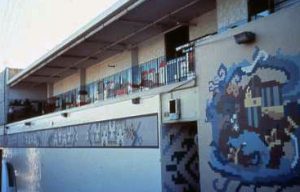
This is the west wall of the exterior of El Mercado. In the foreground is the mosaic tile of the Rain God. Circulating the building on three sides is another mosaic tile of Quetzalcoatl. In the upper level patio, you can see the Taxco village in ceramic tile and mosaic.
Jose Luis designed and executed all the art work for the Hands Across America Program, May 25, 1986, totaling over 60,000 square feet that had to be completed in only eight days in the city of Long Beach, in the parking lot of the Queen Mary, another one over the ticket office for the Queen Mary, a 100’ foot banner, and the stage backdrop.
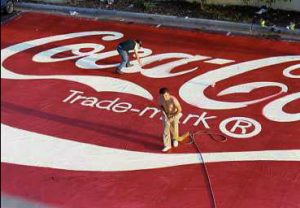
The Hands Across America project was almost a 24/7 project for we had to paint the map of the United States with people holding hands from California to New York that had to accommodate 10,000 people. This picture, above, shows my son in the foreground, Manuel Gonzalez, painting the Coca Cola logo on canvas that was going to be placed over the Queen Mary ticket agency building.
Time Magazine commissioned Jose Luis to design and execute a mural depicting actor, Edward James Olmos, for the front page of the magazine published July 11, 1988. The mural was called “Magnifico”.
Jose Luis was project director and head sculptor for a shrine to “La Virgen de Guadalupe”, designed by Eddie Martinez for the City of Hope’s Rose Garden in the City of Duarte California, and dedicated on May 17, 1989.
Jose Luis was commissioned to design, construct, produce, and decorate a restaurant in Pasadena, California, named Cuernavaca de Noche.
Jose Luis served as an artistic consultant and contractor for the new Tamayo Restaurant in East Los Angeles. In charge of importing all the cantera stone and marble from Mexico, Jose Luis obtained exclusive permission from Maestro Rufino Tamayo to use his name for the name of this establishment, plus provided works of art by the Maestro himself.
Jose Luis designed and executed an 11ft. high by 22ft. wide ceramic tile mural for the interior main play room of the Salesian Boys and Girls Club, in Los Angeles.
Jose Luis was invited, in 1990, to hold a one-man exhibit at the Fresno Art Museum, in Fresno California.
In 1992-1993, Jose Luis was commissioned to design, produce, import all materials, install and decorate Camacho’s Cantina, an exclusive restaurant at Universal Studios City Walk. Jose Luis invited Eddie Martinez to participate in the designing of Camacho’s Cantina.
In 1995, Jose Luis designed, produced, and installed a ceramic tile mural at Don Bosco Technical Institute in Rosemead from which he graduated in 1959.
In 2000, Jose Luis won the commission to design execute and install a 10ft. high by 14ft. wide ceramic tile mural for the Sky Harbor Airport in Phoenix, Arizona, titled “A Bit of the Grand 48th”. It is located at Sky Harbor International Airport, Goldwater Terminal (Terminal 4), Phoenix, Arizona.
Jose Luis was commissioned by CVS Pharmacy to design and produce a ceramic tile mural for their location in the City of Azusa, completed in August of 2005. It was titled, “Azusa as it was, as it is, and as it will be” and was comprised of three separate mural walls.
Jose Luis received the KCET and Union Bank of California, Local Hero of the Year Award, September 13, 2008.
Jose Luis was commissioned to design and produce the “Wall of Honor”, which is part of the Eugene A. Obregon Congressional of Honor Memorial that was dedicated on Saturday, December 5, 2009 at the Father Serra Park, Los Angeles, California and contains the names of 3,456 recipients of the Congressional Medal of Honor, from the Civil War to the most recent conflict at that time.
About 2010, I was informed by UCLA Chicano Studies Research Center that they performed a Latino Art Survey, funded by the Getty Research Institute, and found that GOEZ was the first Chicano arts organization in East Los Angeles in 1969. They reported their findings in a book titled, “Mapping Another L.A.” There was an exhibition at the Fowler Museum and here is a link to Joe Gonzalez’s speech: https://youtu.be/2DqUxCEPwfg
Jose Luis was commissioned to design and produce a large ceramic tile mural for the Lizarraga Family lobby, of the White Memorial Hospital, titled, “Do Not Fear, for I Am Here”, dedicated on April 20, 2010. The mural measures 8 ft. high by 33 ft. wide. He also created and installed a rose garden in memory of his wife, Blanca Rosa Gonzalez, his father, Juan S. Gonzalez, and his father in law, Benjamin Gaytan. It was called, “El Jardin de Blanca Rosa”.
One of the most recent projects that Jose Luis was undertaking was a monument to be dedicated at El Mercado de Los Angeles on First and Lorena in East Los Angeles, Ca. The monument is in honor of the 201 Squadron, the Mexican pilots that trained in Texas and fought alongside with the United States in the Philippines against the Japanese during WWII. The monument is expected to be 16 ft. tall by 25 ft. wide and 6 ft. deep. Unfortunately, the owner of El Mercado, his late friend, compadre, and Patron of the Arts, Pedro Rosado, passed away before he could complete it.
Jose Luis was also commissioned to design and produce a large mosaic mural titled, “Omenaje a La Mujer Mexicana,” that was to be installed at El Mercado de Los Angeles. It was expected to measure to be 16 ft. tall by 32 ft. wide. He painted the piece, unfortunately, the mural met the same fate as the monument of the 201 Squadron.
In 2015, Jose Luis produced his latest mural for the Golden Spur Restaurant in San Dimas, California, off Route 66. The mural which measures 12’ by 12’ is a back drop for the stage for live music and karaoke singers. It depicts many popular singers from the past, country singers and all the karaoke singers that patronize the restaurant regularly. All the singers form the stars that grace the beautiful night sky over the restaurant’s logo that is comprised of a boot outlined in neon lights.
With many more projects and paintings not mentioned here, Jose Luis Gonzalez’s career in the art world commenced in 1957. With other projects too numerous to mention and a gross of disciplines in the art world too few could match, Jose Luis Gonzalez is truly a unique individual and remains a dutiful father who receives the full support of his three sons Joe L. Jr., Manuel, and Arthur. Both the artist and the studio will continue to prosper; all the while, extending a helping hand to the young, up and coming artists, talented individuals, and the community along the way.

